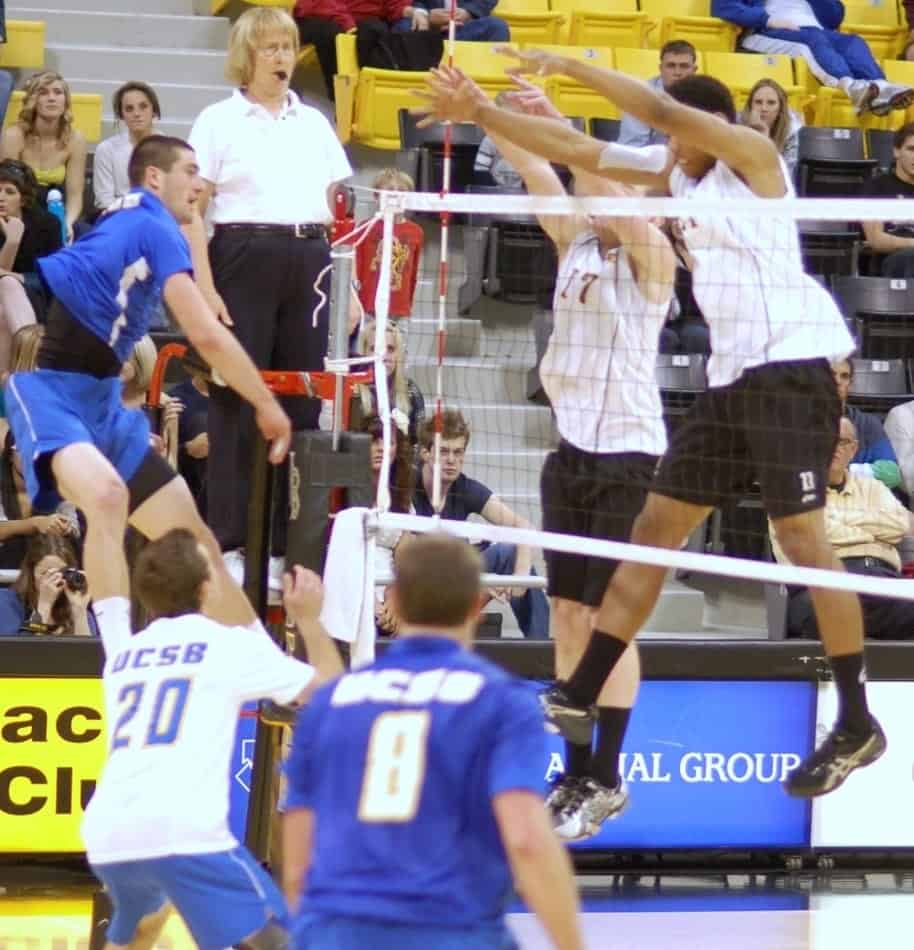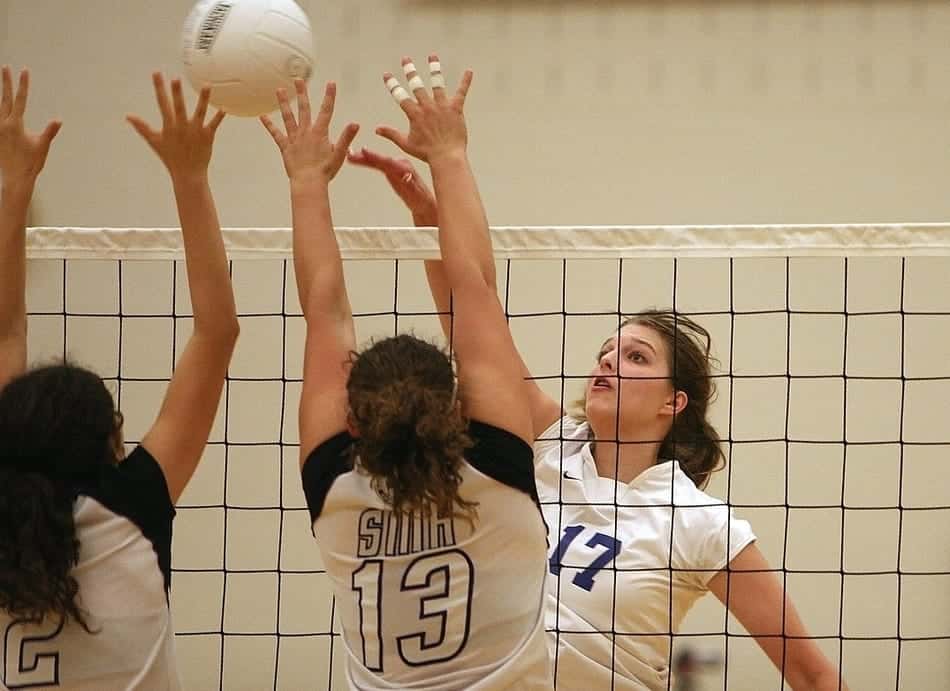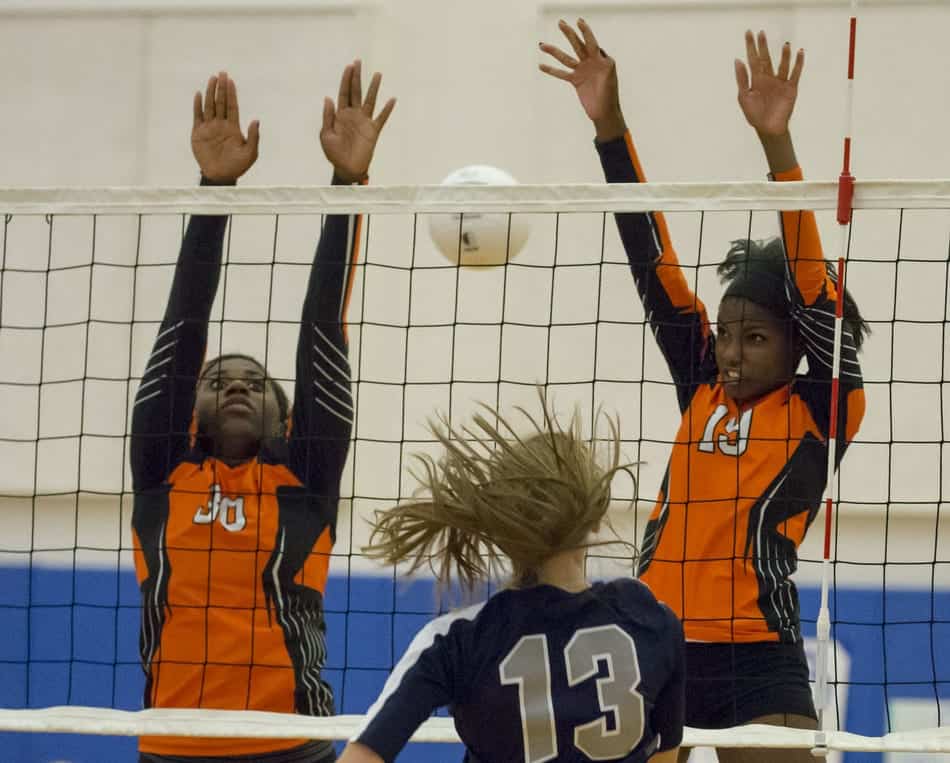In volleyball, there are many rules and they differ from league to league and sometimes from age group to age group. The rules in college volleyball may be different than the levels below it and definitely different, in some cases, to the international rules of the FIVB.
So is it hard to understand all the different rules involving the net in volleyball? Yes! It’s often confusing for fans and parents, sometimes for players, and even occasionally for coaches and even referees to keep track of all the rules involving the volleyball net! This article will break down the rules into bite-sized pieces to help you understand the different situations and scenarios when fouls are called involving the net.

If you would like to shop for the best volleyball for you, check out Recommended Volleyballs.
Who Makes The Rules?
In volleyball, the highest governing body is commonly known by the acronym FIVB. This stands for the Federation Internationale de Volleyball.
You might wonder why it’s a french name when volleyball first became a sport in the USA? Well the FIVB was founded first in Paris, France in 1947. Fun fact: today its headquarters are in Switzerland, and its president is a Brazilian citizen!
The FIVB is truly an internationally diverse group that seeks to promote volleyball as an exciting, entertaining, and fun sport to both watch and play.
So the FIVB maintains rules for international play and then leagues at every level all around the world adjust their rules to match what they deem appropriate for their local games. Each lower level has its own governing body that may adopt all or none of the changes at any time.
Before Going Any Further, A Disclaimer
Volleyball is a sport with many slight differences in the rules from one country to another, one level to another, and one year to another. It has been common practice for the rules to be reviewed and adjusted about every 4 years.
I have personally read through the FIVB Official Volleyball Rules for 2017-2020, all 83 pages.
Feel free to refer to them yourself by downloading the pdf file here.
The following information is based on my understanding at this time. But, these are the rules for international play, your league may follow them or not.
1. Can The Ball Hit The Net While Serving In Volleyball?
Yes, the ball is allowed to hit the net. If it goes over it’s a fair serve, if it doesn’t, the serving team loses the point and possession. Prior to 2001, if the ball hit the net it was a service error whether it went over or not.
2. Can A Player Touch The Net In Volleyball?
A volleyball player can’t make contact with the net during the action of playing the ball. What does that mean? If you touch the net while jumping to hit, hitting, or landing it will be called against you.

This means that this rule has to do with intent. Just by intending to hit the ball, you can get a net fault, even if you miss the ball. Any player that is near the ball, trying to play it and touches the net, is at fault.
3. Can You Touch The Area Of The Net Outside The Sidelines?
Yes, a player may touch the net outside the sideline boundary, the cables or ropes, or the post without triggering a fault. The only exception is that there can’t be any interference in doing this, if there is, it’s a fault.
4. If The Ball Is Driven Into The Net So Hard It Touches Me, Is That A Fault?
No, when the ball is driven into the net and that causes the net to touch the player, there is no fault, the play continues. Basically, you are passive in this situation and can’t be blamed for the net touching you.
5. Playing The Ball Over Net, Can I Interfere With The Opponent’s Play?
If you reach over the net to play the ball while it’s still on the other side of the net, it’s a violation unless:
- The other team has already used all 3 of their hits.
- There are no players close enough to make a play on the ball.
So basically, the only way you would risk making this play is they have no chance to play it and you question whether the ball might make it to your side, so you reach up and block it before it comes over to be safe.
Another similar violation that can happen is if you reach over to touch the ball like this and you touch an opposing player, that’s automatically a foul on you.
6. Can A Player Attack The Ball Coming From The Other Side Of The Net Before It Breaks The Vertical Plane?
No, the attacker must not attack before the ball comes across. They can technically block it as long as no one else is close enough for it to be ruled as interfering with the opponent’s play.
A player may attack the ball as soon as it breaks the vertical plane of the net. Meaning, if any part of the ball touches the imaginary line extending vertically up above the net, players on either side both have access to play it.

So if a hitter waits until the ball touches their space, they can play it even if the setter on the other side is trying to set. This can actually create a strange situation. If the setter on the other side is currently a back-row player in the rotation and they touch the ball simultaneously, the setter should be called for an illegal block!
7. Is It Illegal To Step On The Center Line In Volleyball?
The line in the middle of the court is called the centerline. It is ok for your hand or foot to touch and even cross the centerline, as long as:
- The hand or foot is still touching the line and does not cross completely over into opponent territory.
- There is no interference with your opponent’s play.
So you would be called for a violation if you stepped on the line and it ended up tripping an opponent or something like that.
8. Can My Body Touch The Center Line?
No, it’s a foul for any part of your body besides your hand or foot to touch the centerline at any time during play.
9. Can A Player Lean On The Net To Keep From Falling?
No, a player is not allowed to take support from any structure or teammate. If a player is about to commit a fault by falling into the net or crossing the centerline, a teammate IS allowed to reach out and hold them back or assist them.
10. Is Your Body Allowed To Touch The Net?
Your body may touch the net as long as:
- It doesn’t create an advantage for you.
- As long as you don’t touch the top of the net.
- As long as it doesn’t interfere with your opponent’s play.
- As long as the official doesn’t deem that you used the net as a support to make a play (leaning into the net).
- And as long as you don’t catch or hold onto the net.
11. Can The Ball Hit The Antennae In Volleyball?
The ball is out of bounds if it hits the antennae, the pole or the referee, or the referee’s stand.
12. Can I Play The Ball If It Hits The Net Or Cables Outside The Sideline?
If the ball hits the net outside the sidebands, or the cables, ropes, posts, antennae, the ball is ruled out of bounds and the rally is over.
13. If The Ball Is Out Of Bounds, Can I Play It Over The Net To The Other Side Of The Court?
If your team has hit the ball out of bounds on the other side of the court in the free zone (the area around the court), you can play the ball back onto your side and then back over the net properly as long as you can do it in 3 hits. The player retrieving the ball must not step on the opponent’s court at any time and the opponents may not interfere with their play.
The ball must cross between the antennae and the imaginary extended vertical lines upward to be considered in bounds as it crosses over.
14. Can The Ball Still Be Played After It Bounces Into The Net?
Absolutely! The volleyball will often bounce into the net and players can play it back out and over the net as long as they don’t use more than 3 hits (plus a possible block). Not only is this allowed, but it’s also encouraged! Many teams practice this skill because it’s a difficult situation that happens quite often.

15. What If The Volleyball Crosses Under The Net?
The ball is in play until it has completely passed the vertical plane of the net into the opposing side. As soon as it has made it that far, the play is whistled dead and the point awarded.
So to be clear, the ball is not allowed to penetrate under the net. In some rare instances, a teammate can save the ball as it’s about to go under the net, sending it back to their team to continue the play.
16. Can A Player Go Under The Net In Volleyball?
A player IS allowed to penetrate under the net, into their opponent’s space as long as there is no interference with their play, but your foot must not step completely onto their court.
A player can cross into their opponent’s free zone (the area around the perimeter of the court) as long as it doesn’t interfere with their play. A player can also cross into the opponent’s court after the ball is out of play.
17. Can A Back Row Player Attack The Ball From Above the Net?
Back row players are prohibited from attacking the ball from in front of the attack line at any point during the play. They may jump anywhere behind the line and may even jump toward the net from behind the line and land closer to the net than the attack line. At takeoff, the player must not have touched any part of the front zone or the attack line.
The actual rule is that they may not attack the ball while it is above the plane of the net and while they are in the front zone (in front of the 10-foot line). In general, referees will have a difficult time judging, in real-time, whether the ball was above the net or not from their vantage point upon their stand.
The accepted practice is that they will call any jumping attack as being above the height of the net (whether the player actually contacts the ball at a sufficient height or not).
18. Can You Block Or Spike The Serve In Volleyball?
This question is often asked and the answer is quite simple. You can’t complete a block or an attack hit on an opponent’s service while the ball is above the height of the net and still in your front attack zone.
So in theory, you could perform an attack from behind the attack line on the serve, but honestly, that’s not a very realistic play. If the ball is that high that far back in the court you are usually going to pass it if it’s coming down, or let it go out of bounds if it’s not.
19. Can A Libero Attack The Ball From Above The Net?
The libero has even more restrictions when it comes to attacking the ball. While she is a back-row player and must obey the same rules as other back-row players, the rules about attacking are even more strict.
The libero was initially designed as a purely defensive player, and in international play, is still not allowed to serve!
They are allowed to attack from behind the line, but it must always be from below the height of the net. So when they perform a back-row spike, liberos should not be jumping, they should be standing when they make the strike.
20. What Is The Libero Setting Rule?
When a libero sets (or what the rules call an “overhand finger pass”) from the front zone, no one is allowed to attack that set from above the height of the net. So liberos should try to set from behind the line, even lifting a violating foot if need be.
If they must be in the front zone and need to set, they have 2 options:
- Use an underhand platform pass to set their hitter.
- Call out to their hitter that they need to attack this from a standing position, not jumping into the air. A simple call of “STAY DOWN” can work as long as hitters are aware of what that means beforehand.
Beach Volleyball Net Rules

I read through the entire Official Beach Volleyball Rules 2017-2020 published by the FIVB to compare the rules with the indoor game. It’s 67 pages long and very similar to the manual for the indoor game.
You can download a copy of the rules here.
The court in beach volleyball looks much different, but when it comes to the net, it’s actually very similar. The height regulations are exactly the same as the indoor net.
Most of the rules concerning the net are the same as indoor volleyball, so except for those listed below, assume the same rules as above.
21. Crossing Into Enemy Territory
Is it really allowed to cross into my opponent’s court? Yes, in beach volleyball as long as you don’t interfere with your opponent’s play of the ball, you can.
I remember the first time I saw a beach volleyball player dive under the net to make a save by digging the ball back to her teammate, who played the ball over with the next hit. I was shocked that it was allowed, but it is!
So in beach volleyball, if you have to retrieve a ball that went across the net out of bounds, you can pass under the net, through your opponent’s court and hit the ball back to your teammate, so they can try to play it over through the antennae.
The big difference here is that you are allowed to walk (or run) through your opponent’s court in the sand, while you’d never be allowed to do this indoor.
22. In Beach Volleyball, Blocking Is A Hit
When you compete at the net in beach volleyball, your block counts as 1 of your team’s 3 hits. The blocker can have the next contact, just like in indoor volleyball, but then there will be only 1 hit left to play the ball over.
23. No Back Row Players
On the sand, there are only two players and there aren’t distinct positions when it comes to rotation. So the rules regarding back row players playing at the net in indoor volleyball don’t exist on the beach.
Either player may attack or block at the net at any time.
Related Questions
How High Is A Volleyball Net?
For men, the net is 2.43 meters in height, which is 7 feet, 11 ⅝ inches. For women, the net is 2.24 meters, which is 7 feet, 4 ⅛ inches.
The height is measured at the very center or the net after it is pulled tight. The height of the net on the sides must be exactly equal, and not more than 2 cm more than the height at the center.
What Is A Let Serve In Volleyball?
A let serve is when the ball makes contact with the net during a serve. Before 2001, this was a service error and the serving team lost the point. In today’s volleyball, if the ball hits the net and falls onto your opponent’s side, it’s not an error, it’s an awesome serve!
What Is Rally Scoring In Volleyball?
Rally scoring simply means that every play results in a point, regardless of who served. In the past, a team had to serve the ball and win the rally to gain a point.
This had the potential of extending games when teams would trade possession of the serve back and forth. Rally serving keeps the games quick and exciting and of a predictable length of time.
If you would like to learn more about Rally Scoring, check out this post next.
Photo credits:
Feature image by Dan Morgan on flickr.com: https://creativecommons.org/licenses/by/2.0/, cropped.
UCSB image by KLM volleyball on flickr.com: https://creativecommons.org/licenses/by-nd/2.0/, cropped.
Players #13 & #17 image by Keith Johnston from Pixabay
Blue vs. black & orange image by Keith Allison from flickr.com: https://creativecommons.org/licenses/by-sa/2.0/
Players #44 & #16 image by Dan Morgan on flickr.com: https://creativecommons.org/licenses/by/2.0/
Beach netplay image by C Watts on flickr.com: https://creativecommons.org/licenses/by/2.0/, cropped.
Recent Posts
Athletes, listen up! Do you have a closet full of old jerseys, sweatpants, and tees that you just can't seem to part with? Well, dust them off, because you're sitting on a goldmine of fashion...
You may have heard, or you may have noticed, that there's been a change to the rule about double contact in volleyball. In 2022, an experimental rule change began to be implemented, where the double...
